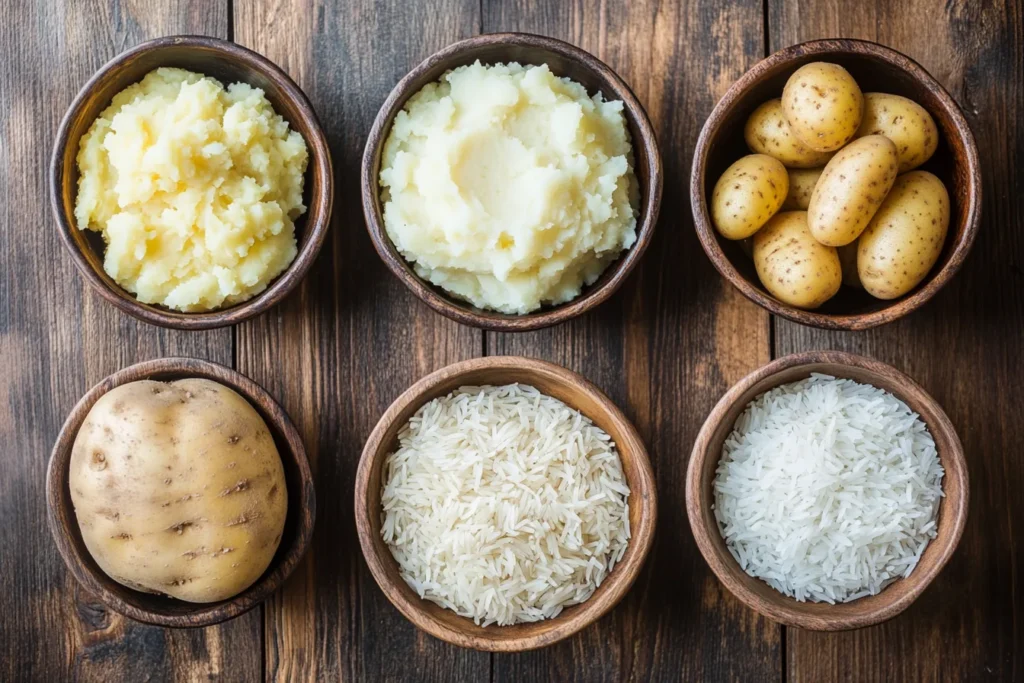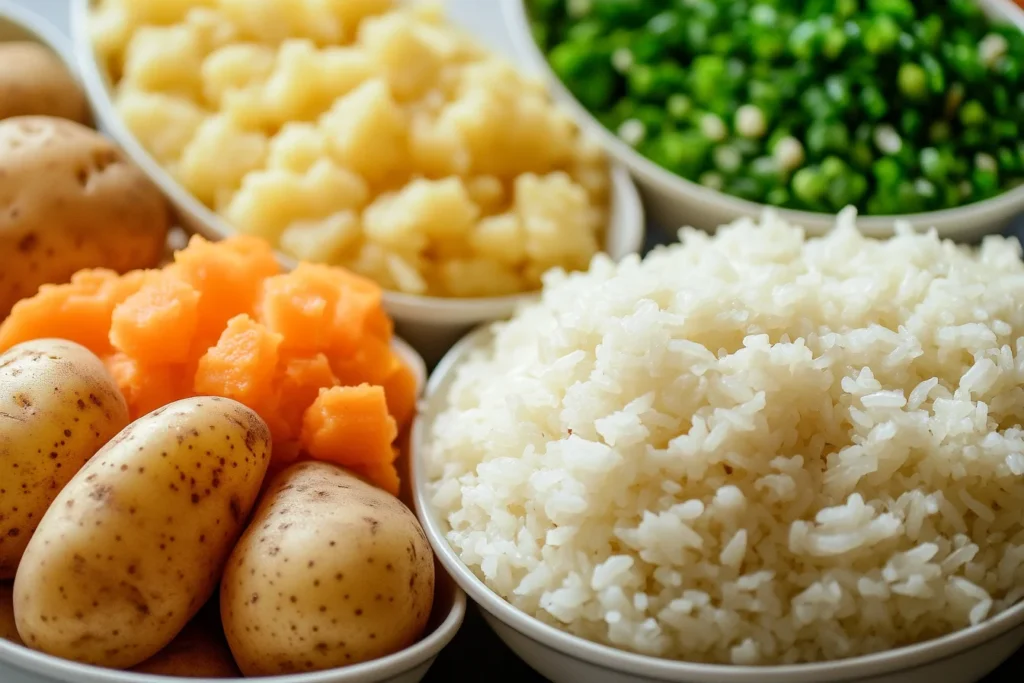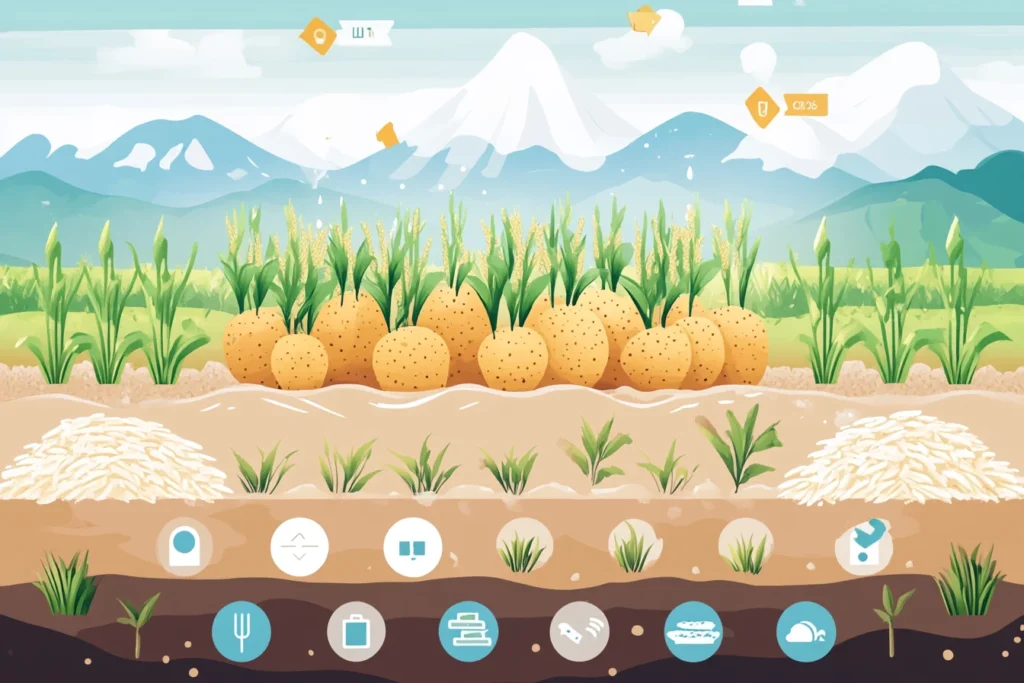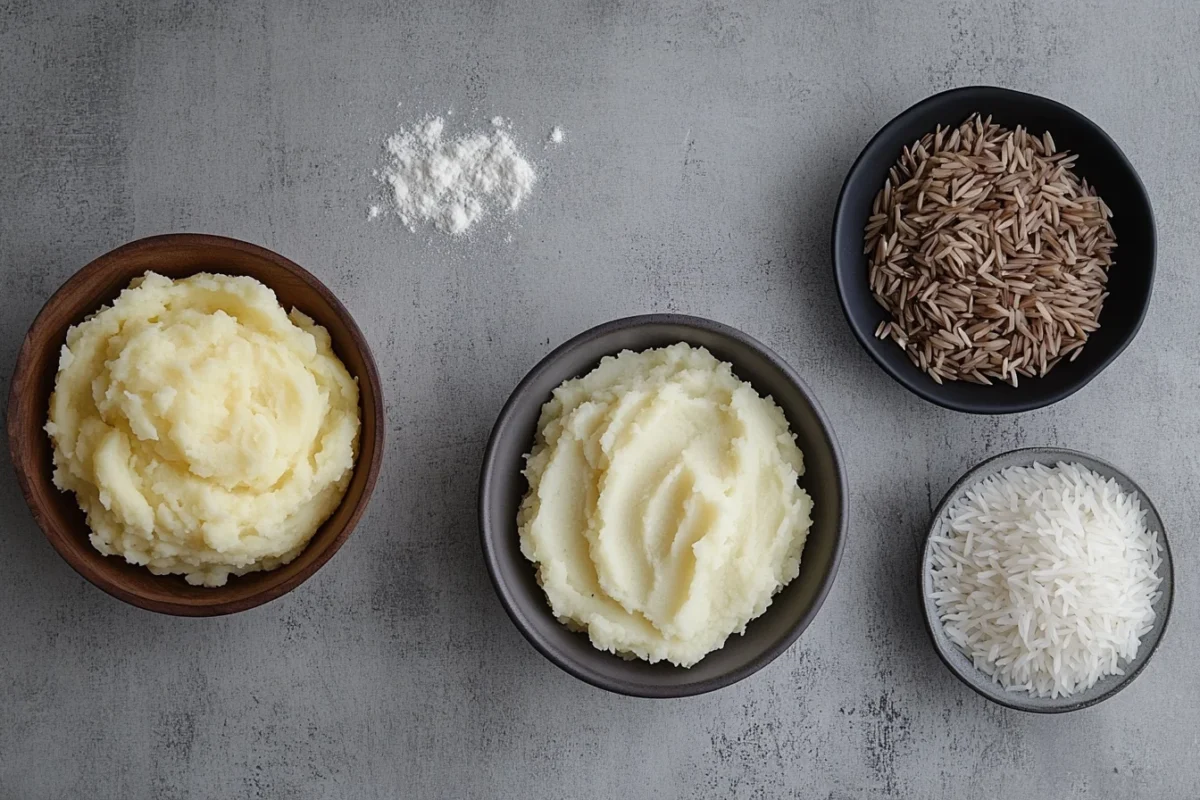Nutritional Profiles
Mashed Potatoes: The Breakdown
Are mashed potatoes healthier than rice? This question often arises because mashed potatoes are a comfort food with hidden nutritional perks. Surprisingly, mashed potatoes are nutrient-dense and a valuable addition to a balanced diet when prepared correctly.
Macronutrients in Mashed Potatoes
Mashed potatoes primarily consist of complex carbohydrates, making them an excellent source of long-lasting energy. They also provide a moderate amount of protein and minimal fat unless ingredients like butter or cream are added, which can alter their macronutrient profile.
Vitamins and Minerals
One of the reasons some argue that mashed potatoes are healthier than rice is their impressive micronutrient content. Packed with vitamin C, potassium, and vitamin B6, mashed potatoes support immune function, muscle contractions, and energy metabolism. These nutrients make mashed potatoes a nutrient-dense option for health-conscious eaters.
Fiber Content in Mashed Potatoes
Fiber plays a key role in the debate about “Are mashed potatoes healthier than rice?” Although mashed potatoes contain less fiber than whole potatoes, they still provide a decent amount, particularly when the skins are included. This dietary fiber supports digestion and helps regulate blood sugar levels. As a result, it’s an important factor when comparing the health benefits of mashed potatoes and rice.
Caloric Content
A standard one-cup serving of mashed potatoes contains roughly 200 calories. However, the calorie count can rise quickly with the addition of butter, cream, or cheese. Compared to rice, the calorie difference depends on portion size and preparation. For those asking, “Are mashed potatoes healthier than rice?”, it’s essential to consider how these additions can impact overall calorie consumption.
Rice: The Nutritional Perspective
Rice, as a global dietary staple, often serves as a versatile and neutral base for meals. But in the debate over whether mashed potatoes are healthier than rice, rice holds its own with its unique nutritional benefits.
This revised section includes the focus keyphrase “Are mashed potatoes healthier than rice” and integrates its synonyms seamlessly while improving keyword density and maintaining readability. Let me know if further tweaks are needed!
- Macronutrients:
White rice is predominantly carbohydrates, with very little protein and negligible fat. Brown rice, however, offers a slightly higher protein content and includes healthy fats. - Vitamins and Minerals:
Rice is an excellent source of folate, manganese, and selenium. These nutrients play vital roles in DNA synthesis, antioxidant activity, and metabolic regulation. - Fiber Content:
Brown rice is a standout here, boasting significantly more fiber than white rice. The bran layer, which is stripped in white rice, provides the fiber that supports gut health and helps manage blood sugar spikes. - Caloric Content:
A one-cup serving of cooked rice contains roughly 200 calories for white rice and slightly more for brown rice due to the higher fiber and fat content.
Comparison: Mashed Potatoes vs. Rice
When comparing mashed potatoes and rice, the differences in their macronutrient profiles stand out. Potatoes deliver more potassium and vitamin C, while rice, particularly brown rice, offers more fiber and essential minerals.
The cooking method dramatically affects their nutritional profiles. Adding rich ingredients like butter to mashed potatoes or frying rice in oil increases their calorie and fat content, altering their health benefits.

Glycemic Index and Blood Sugar Impact
When it comes to maintaining stable blood sugar levels, understanding the glycemic index (GI) of foods is crucial. This metric measures how quickly a food raises blood sugar after consumption. Let’s examine how mashed potatoes and rice differ in their glycemic responses.
Mashed Potatoes and the Glycemic Index
Mashed potatoes rank relatively high on the glycemic index. The boiling and mashing processes break down starches into simpler sugars, making them easier to digest and absorb quickly into the bloodstream.
- Typical GI Value:
Mashed potatoes generally have a GI of around 85, categorizing them as a high-GI food. This means they can cause rapid spikes in blood sugar levels if eaten alone. - Effect on Blood Sugar Levels:
For individuals with diabetes or insulin resistance, high-GI foods like mashed potatoes might lead to unstable energy levels. Pairing them with protein or healthy fats can help slow glucose absorption and mitigate these spikes.
Rice: A GI Comparison
Rice offers a broader range of glycemic index values depending on the variety.
- White Rice:
White rice has a GI between 70 and 90, making it another high-GI option, though slightly less than mashed potatoes. Its quick digestion can also lead to sugar level fluctuations. - Brown Rice:
The GI of brown rice is lower, typically ranging from 50 to 65. Thanks to its higher fiber content, brown rice slows digestion and provides a steadier release of energy.
Health Implications of GI Values
Both mashed potatoes and rice have significant implications for blood sugar management:
- Diabetes Management:
- Foods with a lower GI, like brown rice, are often recommended for those managing diabetes.
- High-GI foods like mashed potatoes should be consumed in moderation or balanced with lower-GI ingredients.
- Energy and Satiety:
- Mashed potatoes may cause a quick energy boost followed by a crash, which can lead to increased hunger.
- Brown rice, with its slower digestion, can keep you feeling fuller for longer.
Choosing the Right Carbs for Blood Sugar Control
Understanding the glycemic index can guide healthier choices. Substituting white rice for brown rice or pairing mashed potatoes with protein-rich toppings can help create a balanced meal.
Health Benefits
Both mashed potatoes and rice offer unique health benefits, making them valuable additions to a balanced diet when consumed mindfully. Let’s examine the specific advantages each brings to the table and how these foods can support overall wellness.
Mashed Potatoes: Nutrient-Packed Comfort Food
Mashed potatoes, often dismissed as merely “carbs,” are surprisingly nutrient-dense and provide several health benefits:
- Rich in Potassium:
One of the standout nutrients in mashed potatoes is potassium. This mineral helps regulate blood pressure, supports nerve function, and balances fluid levels in the body. Just one cup of mashed potatoes contains nearly 20% of the recommended daily intake. - Vitamin C Boost:
While potatoes aren’t citrus fruits, they do offer a respectable amount of vitamin C, which supports a healthy immune system, aids in collagen production, and helps the body absorb iron. - Source of Antioxidants:
Potatoes contain antioxidants like carotenoids and flavonoids, which help combat free radicals and reduce inflammation. This may support heart health and lower the risk of chronic diseases.
Rice: A Global Superfood
Rice, particularly in its whole-grain form (brown rice), offers its own impressive list of health benefits:
- Brown Rice and Whole-Grain Advantages:
Brown rice is a whole grain that retains the bran and germ, making it rich in fiber, vitamins, and minerals. Whole grains are linked to a reduced risk of heart disease, type 2 diabetes, and certain cancers. - Essential Minerals:
Rice, especially brown rice, is a good source of manganese, selenium, and magnesium. These minerals play critical roles in metabolism, antioxidant defense, and bone health. - Digestive Health Support:
The fiber in brown rice promotes regular bowel movements, supports a healthy gut microbiome, and may aid in preventing constipation.
Key Takeaways on Health Benefits
- Mashed Potatoes: Ideal for individuals seeking potassium-rich foods to support heart and muscle health.
- Rice: An excellent choice for those looking for fiber and sustained energy, especially in the form of brown rice.
By understanding these benefits, you can better tailor your diet to meet your personal health goals.
Potential Health Risks
While both mashed potatoes and rice offer valuable nutrients, overconsumption or improper preparation can lead to health concerns. Understanding these potential risks can help you make informed dietary choices.
Mashed Potatoes: Watch the Additions
Mashed potatoes are inherently nutritious, but certain preparation methods and overindulgence can pose risks:
- High Glycemic Index:
As discussed earlier, mashed potatoes have a high glycemic index. This can lead to rapid blood sugar spikes, especially when consumed in large portions without balancing protein or fiber-rich foods. - Added Fats and Sodium:
Many mashed potato recipes include butter, cream, and salt, which can significantly increase calorie, saturated fat, and sodium levels. Over time, excessive saturated fat can impact heart health, and high sodium intake may contribute to elevated blood pressure. - Portion Control Challenges:
Mashed potatoes’ creamy texture and flavor make them easy to overeat, which may lead to unintended calorie surplus and weight gain.
Rice: Addressing Common Concerns
Rice, despite its global popularity, has its own set of potential risks, particularly when consumed frequently or without mindful preparation:
- Arsenic Levels in Rice:
Rice, particularly from certain regions, may contain trace amounts of arsenic. Long-term exposure to arsenic can pose health risks, such as increasing the likelihood of heart disease and certain cancers. Brown rice tends to contain more arsenic than white rice because the bran layer is retained. - Overconsumption and Blood Sugar Impact:
Regular consumption of large portions of white rice, a high-GI food, may contribute to insulin resistance and a higher risk of developing type 2 diabetes. - Nutrient Loss in Polished White Rice:
During processing, white rice loses the bran and germ, which contain valuable nutrients like fiber and B vitamins. Overreliance on white rice in the diet can result in nutrient deficiencies unless paired with other nutrient-dense foods.
Mitigating Health Risks
- For Mashed Potatoes:
- Opt for healthier preparation methods, such as using olive oil or unsweetened almond milk instead of butter and cream.
- Keep portion sizes in check and pair mashed potatoes with lean proteins and vegetables to create a balanced meal.
- For Rice:
- Consider soaking and rinsing rice before cooking to reduce arsenic levels.
- Rotate rice with other grains like quinoa or farro to diversify your diet.
- Choose brown rice for added fiber and nutrients.
Impact of Cooking Methods
How you prepare your food can significantly influence its nutritional value. Mashed potatoes and rice are no exceptions. The right cooking methods can preserve nutrients, enhance health benefits, and minimize potential risks.

Mashed Potatoes: Cooking and Preparation Tips
Mashed potatoes’ nutritional value depends on what’s added during the preparation and how they’re cooked. Let’s break it down:
- Boiling and Nutrient Loss:
Boiling potatoes is the most common method, but it can cause water-soluble nutrients like vitamin C and some B vitamins to leach into the cooking water. To retain more nutrients, consider steaming potatoes instead. - Adding Fats and Creams:
While butter and cream enhance flavor, they also add significant amounts of saturated fat and calories. Opt for healthier alternatives like olive oil, Greek yogurt, or unsweetened plant-based milk to keep the dish lighter without compromising taste. - Including the Skins:
Leaving the skins on during preparation increases the fiber and mineral content of mashed potatoes, adding a slight nutritional edge. Plus, the skins contribute a rustic texture and earthy flavor.
Rice: Cooking Techniques and Their Effects
Rice’s preparation plays a critical role in its healthiness. Whether you choose white or brown rice, here’s what you need to know:
- Boiling and Steaming:
The most straightforward methods, boiling and steaming, preserve rice’s nutritional integrity while keeping calorie counts low. However, avoid overcooking rice, as this can make it overly soft and increase its glycemic index. - Soaking and Rinsing:
Soaking and rinsing rice before cooking not only removes excess starch (reducing the GI slightly) but also helps to lower arsenic levels, particularly in brown rice. - Avoiding Frying:
Fried rice dishes can be delicious, but they come with higher calorie and fat content due to added oils and often include less healthy additions like processed meats or high-sodium sauces.
Preserving Nutrients While Enhancing Flavor
Here’s how to make your dishes healthier without sacrificing taste:
- For Mashed Potatoes:
- Use low-fat milk or broth instead of cream.
- Add roasted garlic or herbs like rosemary for extra flavor without added fats.
- For Rice:
- Pair it with nutrient-rich vegetables, lean proteins, and healthy fats.
- Experiment with spices like turmeric or cumin to enhance taste naturally.
The way you prepare mashed potatoes and rice can either boost their health benefits or turn them into less nutritious indulgences. Mindful preparation makes all the difference.
Dietary Considerations
When deciding between mashed potatoes and rice, dietary goals and restrictions play a pivotal role. Both foods can fit into a balanced diet, but understanding their impact on weight management, specific health conditions, and dietary preferences is essential.
Weight Management: Portion Control is Key
Both mashed potatoes and rice can contribute to weight gain or loss depending on portion size and preparation methods.
- Mashed Potatoes:
- Mashed potatoes can be filling, thanks to their complex carbohydrates and water content. When prepared healthily (e.g., without excessive butter or cream), they provide energy with fewer calories than many assume.
- Including the skin enhances satiety due to the added fiber, helping control hunger.
- Rice:
- Rice, especially brown rice, provides slow-digesting energy and can keep you full longer. However, white rice’s higher glycemic index may lead to faster hunger cues if eaten alone.
Pro Tip: Pair either with lean proteins and non-starchy vegetables to create a more satisfying and nutrient-dense meal.
Dietary Restrictions and Preferences
- Low-Carb Diets:
Both mashed potatoes and rice are high in carbs, making them less suitable for strict low-carb or ketogenic diets. However, mashed potatoes made with cauliflower or low-carb rice alternatives like cauliflower rice can be excellent substitutes. - Gluten-Free Options:
Both mashed potatoes and rice are naturally gluten-free, making them safe choices for individuals with celiac disease or gluten sensitivity. However, always check for cross-contamination or added ingredients in processed versions. - Diabetic Diets:
- Brown rice, with its lower glycemic index, is generally a better option for managing blood sugar levels.
- Mashed potatoes can still be included but should be paired with proteins or healthy fats to slow glucose absorption.
Cultural and Individual Preferences
- In some cultures, rice serves as a daily staple, while mashed potatoes are more common in Western diets.
- Personal taste and preparation traditions also influence preferences, with both foods offering versatile culinary applications.
Whether you’re watching your weight, managing a condition, or following a specific eating plan, mashed potatoes and rice can both find a place in your diet with a little customization.
Cultural and Culinary Uses
Both mashed potatoes and rice are culinary cornerstones across the globe, shaped by cultural traditions and preparation styles. Their versatility in cooking makes them staples, but the way they are used and perceived significantly influences their health benefits.
Mashed Potatoes: Comfort Food with a Global Twist
Mashed potatoes are widely regarded as a quintessential comfort food in Western diets, often accompanying roasts, stews, or holiday meals.
- Traditional Dishes:
- In the United States, mashed potatoes are a Thanksgiving staple, often paired with gravy or cranberry sauce.
- In Europe, particularly the UK and Ireland, mashed potatoes serve as a base for shepherd’s pie or are paired with sausages in the dish “bangers and mash.”
- Global Variations:
- In Scandinavia, mashed potatoes are served with fish dishes, emphasizing the food’s adaptability.
- Some regions incorporate garlic, herbs, or even root vegetables like parsnips to elevate flavor and nutrition.
Rice: A Global Staple
Rice transcends borders, playing a starring role in cuisines from Asia to Latin America. Its versatility allows it to be prepared in countless ways to suit both savory and sweet dishes.
- Cultural Significance:
- In Asia, rice is a symbol of sustenance and prosperity. It is steamed, fried, or turned into sushi, rice cakes, and noodles.
- In Latin American cuisine, rice is often paired with beans, forming a complete protein source. Dishes like arroz con pollo (rice with chicken) are household staples.
- Preparation Influences Health:
- While plain steamed rice is the healthiest option, cultural dishes like fried rice or risotto often involve added fats and sodium.
- In Mediterranean cuisine, rice is cooked with olive oil and herbs, offering a heart-healthy twist.
How Preparation Shapes Health Perception
Both foods’ healthiness can be affected by cultural methods of preparation:
- Mashed potatoes served with heavy gravy or fried toppings can lose their nutritional value.
- Similarly, rice cooked in oils or paired with sugary sauces may contribute to excess calorie intake.
Cultural variations highlight the versatility of these staples, but it’s essential to adapt traditional recipes for a modern, health-conscious diet when needed.
Environmental Impact
Beyond health considerations, the production of mashed potatoes and rice also affects the environment. Examining their ecological footprints can help make more sustainable dietary choices.

Mashed Potatoes: A Relatively Eco-Friendly Option
Potatoes, as a crop, tend to have a smaller environmental footprint compared to rice. Here’s why:
- Water Usage:
Potatoes require significantly less water to grow than rice. On average, producing a kilogram of potatoes uses about 287 liters of water, whereas rice requires thousands of liters per kilogram. - Fertilizer and Pesticide Use:
While potatoes do rely on fertilizers and pesticides, they generally need less than rice paddies, which are prone to pests and diseases due to their wet growing conditions. - Greenhouse Gas Emissions:
Potato farming produces lower methane emissions compared to rice paddies. Rice fields, flooded for cultivation, create anaerobic conditions that release significant amounts of methane, a potent greenhouse gas.
Rice: Environmental Challenges
Rice is a vital crop for feeding the global population, but its production raises environmental concerns:
- Water Consumption:
Rice farming is highly water-intensive, accounting for nearly 30% of global freshwater use in agriculture. Sustainable water management practices are essential to reduce its impact. - Methane Emissions:
Flooded rice fields are a major source of methane emissions. Efforts like alternate wetting and drying (AWD) can help reduce these emissions, but adoption rates vary globally. - Soil Degradation:
Continuous rice cultivation can deplete soil nutrients and increase the need for chemical inputs like fertilizers, which can harm local ecosystems.
Sustainability Tips for Choosing Between the Two
Support Sustainable Practices:
Look for rice brands that implement water-saving methods and low-emission farming practices.
Opt for potatoes grown using organic or regenerative farming methods to reduce chemical use.
Diversify Your Diet:
Incorporating other grains and starches, like quinoa or sweet potatoes, can reduce dependence on environmentally taxing crops like rice.
Minimize Food Waste:
Whether choosing mashed potatoes or rice, use leftovers creatively to avoid food waste, which contributes significantly to global carbon emissions.
The environmental footprint of mashed potatoes and rice differs substantially, with potatoes often being the more sustainable choice. However, mindful sourcing and preparation of either option can help minimize their ecological impact.
Frequently Asked Questions (FAQs)
Is it better to eat rice or potatoes?
The answer depends on your dietary goals and health needs. Potatoes are an excellent source of potassium, vitamin C, and other essential nutrients, while rice, particularly brown rice, provides more fiber and long-lasting energy. For managing blood sugar, brown rice is typically the better option due to its lower glycemic index. However, if you need quick energy, potatoes might be more suitable.
Which is healthier, rice or mashed potatoes?
Mashed potatoes can be a healthier option when prepared without excessive butter or cream, as they are rich in vitamin C, potassium, and fiber, especially when the potato skins are included. These nutrients support heart health, immune function, and digestion.
Brown rice, however, often edges ahead for its higher fiber content and essential minerals like manganese and magnesium, which are beneficial for energy metabolism and bone health. Ultimately, the healthiest choice depends on preparation methods and the nutrients you value most.
Are mashed potatoes healthy for a diet?
Mashed potatoes can fit into a healthy diet when prepared thoughtfully. For a lighter version, use low-fat milk or broth instead of cream and limit butter to keep calorie and fat content under control. Including the potato skin increases fiber, enhancing fullness and digestive benefits.
That said, portion control is crucial to prevent overeating, as mashed potatoes can be calorie-dense, especially with rich add-ins. When prepared with care, they’re a satisfying and nutritious choice.
Why do bodybuilders eat rice and not potatoes?
Bodybuilders favor rice, particularly white rice, because of its fast-digesting carbohydrates, which provide a quick energy boost before or after workouts. White rice is also easy to digest, minimizing the risk of stomach discomfort during intense exercise, and it pairs seamlessly with protein-rich foods like chicken or fish.
Potatoes, while nutrient-dense, may not deliver the same immediate energy due to their slower-digesting carbohydrates. However, some bodybuilders do include potatoes in their diet for their high potassium content, which aids muscle recovery and reduces cramping. Both foods can support fitness goals when used strategically.
Conclusion
Are mashed potatoes healthier than rice? The answer isn’t straightforward, as both foods have unique nutritional profiles and benefits. While mashed potatoes excel in providing potassium and vitamin C, rice—particularly brown rice—offers more fiber and sustained energy. The best choice depends on your health goals, dietary needs, and how you prepare each dish.
Key Takeaways
Mashed Potatoes:
- Known for their potassium and vitamin C, mashed potatoes support heart health and immune function.
- They have a high glycemic index, so pairing them with proteins or healthy fats helps stabilize blood sugar.
- Using healthier preparation methods like olive oil or low-fat milk can make mashed potatoes a more diet-friendly option.
Rice:
- Brown rice is a rich source of fiber and essential minerals, making it a better choice for digestive health and long-lasting energy.
- White rice, while less nutrient-dense, is easy to digest and ideal for quick energy boosts.
- Preparing rice using sustainable practices like rinsing and soaking minimizes risks, such as arsenic exposure.
Tips for Incorporating Both Foods into Your Diet
- Balance meals by combining mashed potatoes or rice with lean proteins, healthy fats, and non-starchy vegetables.
- Experiment with healthier cooking techniques—steamed rice and skin-on mashed potatoes are excellent options.
- Rotate these staples with alternatives like quinoa, sweet potatoes, or cauliflower rice for a more diverse nutrient intake.
By exploring the question “Are mashed potatoes healthier than rice?”, we see that each food offers distinct advantages. Enjoying these staples in moderation and tailoring preparation to your goals ensures they fit seamlessly into a healthy, balanced diet.

